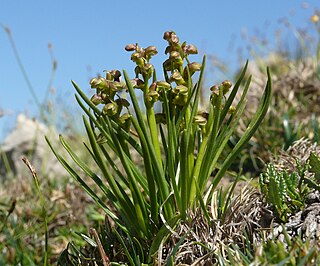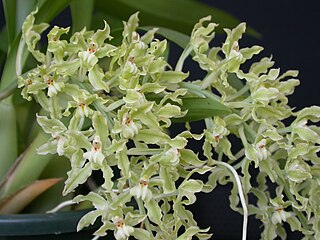
The Pleurothallidinae are a neotropical subtribe of plants of the orchid family (Orchidaceae) including 29 genera in more than 4000 species.
The taxonomy of the Orchidaceae has evolved slowly during the last 250 years, starting with Carl Linnaeus who in 1753 recognized eight genera. De Jussieu recognized the Orchidaceae as a separate family in his Genera Plantarum in 1789. Olof Swartz recognized 25 genera in 1800. Louis Claude Richard provided us in 1817 with the descriptive terminology of the orchids.. The next step was taken in 1830-1840 by John Lindley, who recognized four subfamilies. He is generally recognized as the father of orchid taxonomy. The next important step was taken by George Bentham with a new classification, recognizing subtribes for the first time. This classification was first presented in a paper that Bentham read to the Royal Society in 1881. Then it was published in 1883 in the final volume of Genera Plantarum. The next great contributors were Pfitzer (1887), Schlechter (1926), Mansfeld (1937), Dressler and Dodson (1960), Garay, Vermeulen (1966), again Dressler (1981). and Burns-Balogh and Funk (1986). Dressler's 1993 book had considerable influence on later work.

The Orchidoideae, or the orchidoid orchids, are a subfamily of the orchid family (Orchidaceae).

Vanilloideae is one of the subfamilies of orchids belonging to the large family Orchidaceae.

Maxillaria, abbreviated as Max in the horticultural trade, is a large genus of orchids. This is a diverse genus, with very different morphological forms. Their characteristics can vary widely. They are commonly called spider orchids, flame orchids or tiger orchids. Their scientific name is derived from the Latin word maxilla, meaning jawbone, reflecting on the column and the base of the lip of some species, that may evoke a protruding jaw.

Peristeria is a genus of plants of the family Orchidaceae commonly called dove orchid or Holy Ghost orchid. In line with the common name, the genus' name is from the Greek word peristerion meaning "from dove". According to the Royal Horticultural Society, Per is the official orchid abbreviation for this genus. In nature, it is found across much of South America as well as in Panama, Costa Rica and Trinidad.

Disperis is a genus of plants in the orchid family, Orchidaceae. It has about 78 species. Most of the species are from tropical and southern Africa, as well as Indian Ocean islands. A few are native to the tropical or the warmer subtropical regions of Asia and Malesia.

Chamorchis is a genus of flowering plants from the orchid family, Orchidaceae. It contains only one known species, Chamorchis alpina, known as the false orchid or false musk orchid, and found in subarctic and subalpine parts of Europe: Scandinavia, the Alps, the Carpathians, northern European Russia.

Cleisocentron is a genus of flowering plants from the orchid family, Orchidaceae. It has a disjunct distribution, known from the Himalayas, Vietnam and Borneo. Six species are currently recognized:
- Cleisocentron abasiiCavestro - Sabah
- Cleisocentron gokusingiiJ.J.Wood & A.L.Lamb - Sabah
- Cleisocentron kinabaluenseMetusala & J.J.Wood - Sabah
- Cleisocentron klossii(Ridl.) Garay - Vietnam
- Cleisocentron merrillianum(Ames) Christenson - Sabah
- Cleisocentron pallens(Cathcart ex Lindl.) N.Pearce & P.J.Cribb - eastern Himalayas
Cotylolabium is a genus of flowering plants from the orchid family, Orchidaceae. It contains only one known species, Cotylolabium lutzii, endemic to Brazil.

Eriopsis is a genus of flowering plants from the orchid family, Orchidaceae. Its species are native to South America and Central America.
- Eriopsis bilobaLindl.
- Eriopsis grandibulbosaAmes & C.Schweinf.
- Eriopsis mesaeKraenzl.
- Eriopsis rutidobulbonHook.
- Eriopsis sceptrumRchb.f. & Warsz.

Gomesa is a genus of flowering plants from the orchid family, Orchidaceae. It contains about 80–100 species, all native to South America.

Grobya is a genus of flowering plants from the orchid family, Orchidaceae. It contains 5 known species, all endemic to Brazil.
- Grobya amherstiaeLindl.
- Grobya cipoensisF.Barros & Lourenço
- Grobya fasciferaRchb.f.
- Grobya galeataLindl.
- Grobya guieseliiF.Barros & Lourenço

Herpysma is a genus of flowering plants from the orchid family, Orchidaceae. It contains only one known species, Herpysma longicaulis, native to Southeast Asia.

Telipogon is a genus of flowering plants from the orchid family, Orchidaceae. It is a large genus with dozens of species, native to South America, Central America, Hispaniola and southern Mexico.
Nothostele is a genus of flowering plants from the orchid family, Orchidaceae. It contains two known species, both endemic to Brazil.
Sutrina is a genus of flowering plants from the orchid family, Orchidaceae. The genus contains only two known species, both endemic to South America.

Dendrobieae is a tribe in the subfamily Epidendroideae, in the family Orchidaceae.

Diseae is an orchid tribe in the subfamily Orchidoideae. It was recognized in Genera Orchidacearum volume 2, which was published in 2001. It consisted of 12 genera in five subtribes. In molecular phylogenetic studies that were published after 1999, it was shown that Diseae is paraphyletic over the tribe Orchideae. In a classification of orchids that was published in 2015, Diseae was not recognized, but was instead placed in synonymy under Orchideae.

Maxillariinae is an orchid subtribe in the tribe Cymbidieae. It was formerly treated as the tribe Maxillarieae, and divided into a number of subtribes.
















